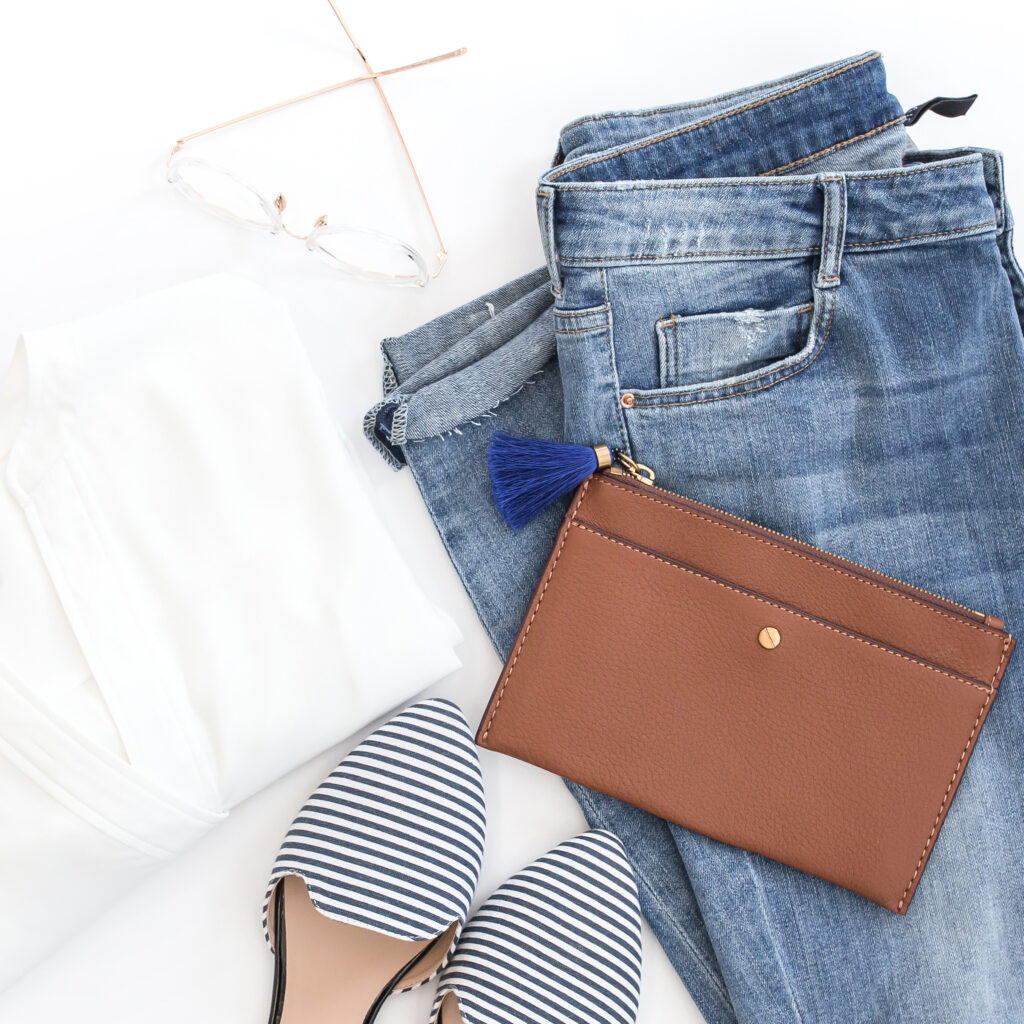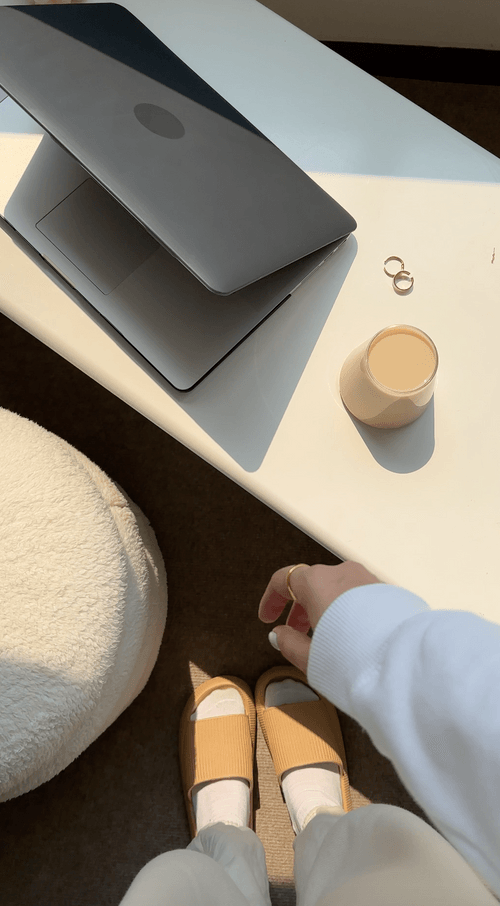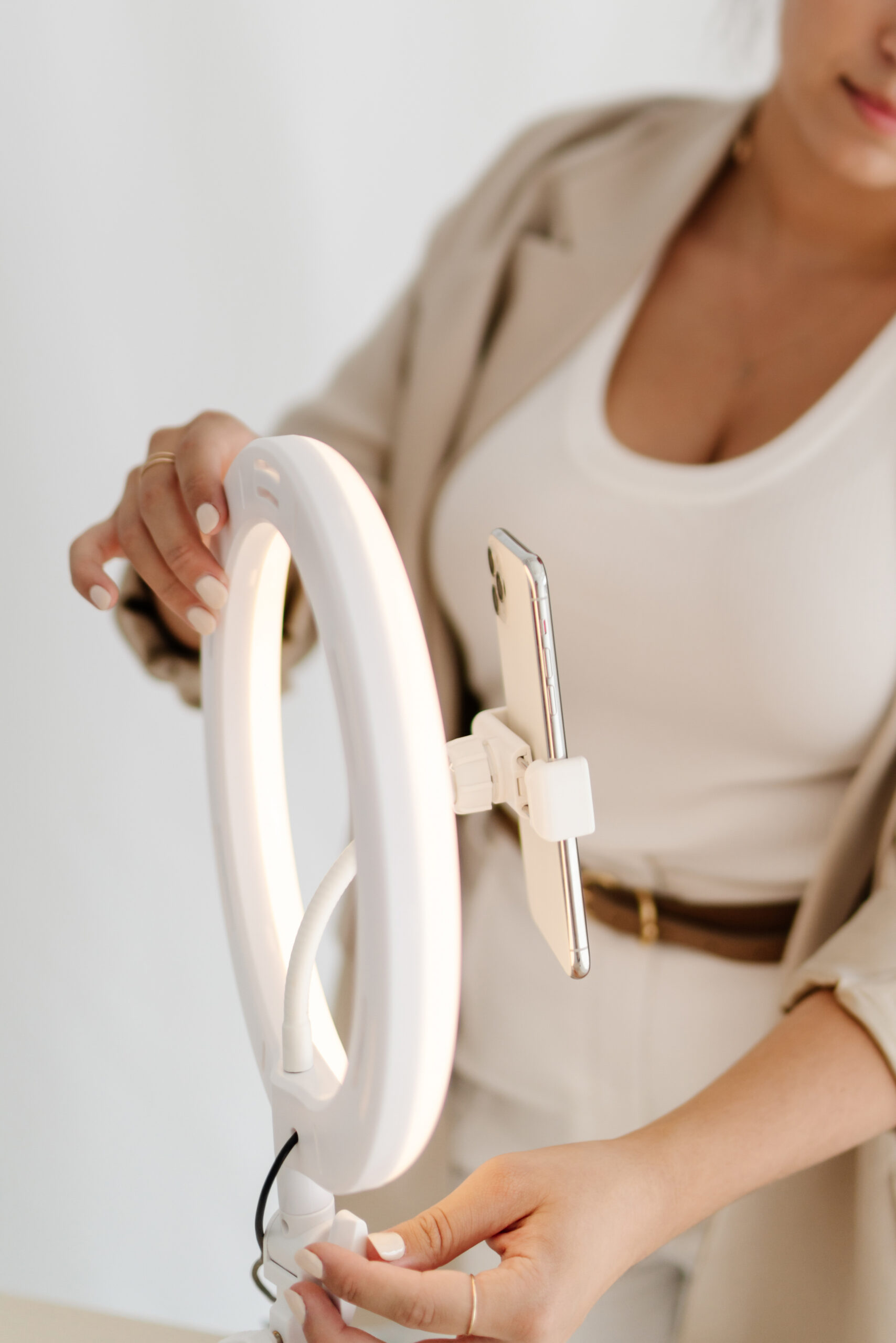How to Make Money Selling Clothes Online
Have you always dreamed of making money selling clothes online? Whether you’re just trying to sell your pre-loved clothes to earn some extra cash (hello $500 for flights) or looking to make this the start of a full-time business, these tips will guide you through the process of how to successfully start an online fashion business. With some good lighting, great photos and a solid strategy for your side hustle, you can easily transform your wardrobe into a source of income. This step by step guide will show you some of the ways you can make money selling clothes online.

Where to Sell Clothes Online
If you’re just getting started in the world of selling pre-loved fashion then there are generally a couple of options to consider. These are: Vinted, eBay, Vestiaire, Facebook Marketplace, and Depop. You do not need your own website to get started with selling your new or pre-loved clothing online. Although as your side hustle grows, you may want to consider turning it into a full-time business as an online clothing retailer and starting your own website. For now though, the cheapest and easiest way to get started is using the reseller tools available.
Each platform has its own vibe and preferred inventory. Before you waste time jumping in and listing your items on a platform that might not be the most suitable for your items, this is what you need to know about each selling platform:
- Vinted: VInted is a great place to sell everyday clothing and accessories. There are no seller fees, so you can profit more from every sale you make. Vinted has earned itself a reputation as selling reasonably priced, bargain fashion, so it’s the perfect place to resell your high-street clothes but less suitable for any high-end, designer pieces you may want to sell. When selling on VInted, usually you’re only able to sell nationally to buyers in your own country, which means that you don’t have to calculate overseas shipping costs but on the other hand, your listings are only visible to people in your region.
- eBay: eBay has been around for years and is one of the original online selling platforms. eBay has many selling options, from their auction listings, Buy it Now, and Best Offer feature, which enables buyers to negotiate a price with you. If you want to ensure that you’re getting the best price for your unwanted clothes then the auction listings are the way to go. You can use eBay to sell a range of items besides from clothing, as well as both luxury and budget fashion. If you want to experiment with opening your own ecommerce business then you can even open your own eBay shop and incorporate your own branding if you want to turn this side hustle into a full-time business one day.
- Vestiaire Collective: If you’re looking for the best place to sell your designer pieces, then Vestiaire is the best place to list them. Vestiaire specializes in luxury and premium brands and does not sell high-street or mid-level brands. The Vestiaire community understands designer goods, so if you want to sell your luxury items for the price they’re worthy of then this is the best platform to do so. There is also the option to have Vestiaire conduct authenticity checks to ensure that designer items are not fakes, making the platform more secure and trust-worthy for both buyer and seller, as well as tips on how to price second-hand designer clothes and what they typically sell for.
- Depop: Depop is similar to VInted, mainly specializing in fashion and accessories, except that on Depop there is more room for quirky, vintage items, unique finds and the ability to sell internationally. Depop is also the best place to sell vintage clothes online. Their app makes it quick and simple to list items and you can decide on whether you want to sell solely to customers in your own country, region or internationally.
- Facebook Marketplace: Most people already have a Facebook account, so selling your clothes on their marketplace is a convenient way to sell clothes online. It takes just minutes to list an item and you can reach a large audience of potential customers in just a few clicks. Selling clothes on Facebook Marketplace has become so popular that sellers are even turning this side hustle idea into a full-time business as a clothing reseller. It’s also a great place to sell bundles of items, if you want to sell multiple items at once.
Tip: Choose a platform that suits your clothing style and target audience. For instance, vintage treasures might sell better on Depop, while high-end items will be more appreciated on Vestiaire.
Reselling Clothes Tips: Deciding What Clothing to Sell Online
Before you start photographing items and listing them to sell, have a good sort out and work out what you should sell. Between the platforms listed above, there is a good chance that you can sell just about anything, but to make a good first impression you will need to seriously think about quality. Sure, there are many stories of online sellers making money from old, wornout boots and even selling chewing gum for a profit! However, you need to be realistic. With the right marketing, you can sell just about anything but this isn’t about a quick PR stunt, so examining the quality of your pre-loved clothes will give you a better chance of selling them for a decent price.
Go through your closet and take out items you are thinking of selling. Next, carefully examine each item to check for piling, bobbling, any stains, rips or any defects that need to be mentioned if and when you sell. If your pre-loved clothing is in really poor condition then you might want to reconsider selling it and instead, recycle it as textile waste. Always put yourself in the place of the customer when selling your unwanted clothes. How would you feel if you bought this item and would you be happy with the quality? In most cases, you could just photograph the garment and detail any defects or signs of wear in the listing description. The exception to this rule is when selling designer clothing and accessories. Luxury clothing and accessories are generally made from better quality and more durable materials, which collectors are more likely to pay to have repaired. There are many businesses online and offline that offer fashion repairs for luxury items, so as long as you clearly detail these when selling, you could still sell them successfully for a worthy price.

How to Get Good Product Photography for Selling Clothes Online
Product images are make or break when it comes to selling clothing online. Why go to all that trouble sorting out your second hand clothes to sell, washing and ironing them and spending the time listing each one, only for your poor product photography to prevent them from selling. With good product photography shots, you can make any item look visually appealing and increase its chances of selling. On the other hand, with poor product photography you can instantly make a beautiful, luxury item appear unappealing, unsellable even.
In recent years, thanks to technology advances with Smartphone technology, it’s never been easier to capture great product photography using just our phones. This also means that there isn’t an excuse anymore to not use good product images. Back in the day, when people first started selling on eBay, customers didn’t expect individual sellers to list items with professional level photos. Now however, the selling sphere is very different. Anybody and everybody can easily improve their product photography and increase their chances of selling goods by taking into consideraton the following product photography tips;
- Lighting: Natural light is your best friend, especially if you’re on a budget and just starting out. Snap your clothes near a window during the day for that soft, flattering glow. Generally speaking, natural lighting is always the best form of lighting but if lighting is an issue or you want to invest in better lighting equipment, consider purchasing a product photography lightbox to make your photos look more consistent and professional. A product photography lightbox will give you full control on light, backdrop and brightness, making it more convenient to capture product photography at any time of the day or night.
- Background: Keep it clean and clutter-free to really show off your items. This photography lightbox comes with a range of backdrops that you can change in seconds. Never photograph your items on a stained or dirty surface, as this will devalue your professionial image and item’s value. Use props sparingly if you feel the need to add in props. The use of props is best suited to your own website or social media platforms to create lifestyle photography, rather than as the main product photos used on selling platforms.
- Angles: Capture multiple angles—front, back, and close-ups of any unique details or labels. You should also photograph any signs of wear or imperfections rather than trying to hide them and always make sure that you state these clearly in your product descriptions. Getting a variety of images at different angles will help the buyer to get an idea on the shape, style and size of the garment or accessory.
- Model It: If possible, wear the item. It helps potential buyers visualize fit and style. Flatlay photos are great for seeing the item on it’s own and highlighting any important details, whereas photos of the item worn by a model will help the buyer to visualize how the garment will look on them.

Write Compelling Descriptions
Your descriptions should provide additional information to your photos. Include key details like brand, size, material, and condition. Don’t be afraid to add a bit of personality—tell a story about the item or suggest styling tips. As you write your product descriptions, try to answer any questions that potential customers might have. Not only will this help to build trust and reputation, it will save you time by not having to individually answer every seller who private messages you asking for this information.
How to Price Clothes to Sell Online
Pricing can be tricky when selling clothes online. You want to make a profit but you also want the item to sell by listing it at a realistic price. It’s important to do a bit of market research beforehand so that you set realistic prices when reselling your clothes. Here are some guidelines for pricing pre-loves clothes:
- Research: Research similar items from the same brand to see what they typically sell for. While luxury items may gain value over time, high-street fashion drastically devalues. Make sure that you’re not about to lose out on the chance of profits or a sale by doing your research first. If you’re selling on Vestiaire, their in-build recommendation will give you advice on how to price second-hand designer clothes and let you know what similar items sell for. This guide value isn’t always correct, so it’s worth researching the selling price of other materials, brands and styles beforehand. For example, the recommended price of a silver bracelet may drastically differ depending on whether it’s by an unknown brand or Tiffany & Co.
- Condition: Adjust your pricing for wear and tear. Brand new or like-new items can demand higher prices, whereas items in satisfactory or well loved condition should be discounted accordingly.
- Shipping: Whether you’re selling locally or internationally, you need to factor in shipping costs. If you’re using platforms like VInted or Vestiaire then shipping will usually be taken care of for you. With that said, you still need to consider the cost of shipping when setting the price of your listing. Consider slightly decreasing the listing price to allow for the additional shipping fee or if you’re calculating postage costs yourself, think about including it into the product price and promoting free shipping to create a good deal. You could also offer discounts for those who purchase multiple items at once.
Fun Tip: Set a financial goal, like funding a trip or investing in better quality photography equipment to improve your clothing reseller business, to keep you motivated. Every sale brings you closer to that $500 target (or whatever financial goal you’ve set)!
Promote Your Listings
Put social media to good use to boost visibility and grow your audience. Share your listings on platforms like Instagram or Facebook. You never know who might be looking for that exact item! Plus, social media is the perfect place to experiment with product photography and lifestyle shots to really show off your products.
Engage with Your Audience
Respond to messages from customers promptly and with a friendly tone. Excellent communication from friendly, helpful sellers helps to boost reputation and credibility. It’s all about that customer experience. Answer messages and questions promptly and provide additional details if needed. Building trust can lead to repeat customers and more sales!

Manage Inventory Efficiently
Keep track of what has been selling well and what doesn’t sell so well. Consider seasonal trends—summer dresses might not move in winter, but cozy sweaters will! Similarly, nobody is looking for Halloween costumes near to Valentine’s Day, so sell and promote your products according to the time of year. Don’t forget to update stock quantities or mark items as sold if they’re no longer available. Although it’s an easy mistake to make, you could harm your positive feedback score by having to cancel a sale after a customer purchases an item that has already sold or that has sold on another platform.
How to Sell Your Clothes Online Step by Step
Now that you’re ready to start selling clothing online, here is a step by step guide to preparing your clothes before selling and what to do after making your first sale.
Preparing Your Clothes Before Selling
Before you list your items, it’s vital to ensure they are in the best possible condition. Here are some tips for cleaning and preparing your clothes before photographing and listing them to sell:
- Spot Clean Stains ASAP: No matter how hard you try and prevent it, clothes will eventually pick up stains. Spot clean as soon as possible using a neutral pH detergent. Make sure you read the care label beforehand and use a cleaning product suitable for the fabric type to avoid damage to the garment. Different fabrics require different care methods. Cotton shirts can typically go in the washing machine on a cold, gentle cycle, while wool and silk garments often need hand-washing.
- Air Dry in a Cool, Dry Place: Use a wide, sturdy wooden hanger to hold the shape of your garments and prevent wrinkles. If your garment has sleeves, use clothing pegs to close each sleeve in order to keep their shape and stop them from stretching as they dry.
- Swap the Iron for a Steamer: Avoid heat damage by using a steamer instead of an iron, especially for delicate fabrics like velvet and cashmere. Steamers are more conveient to work with and you also don’t need a bulky ironing board either.
- Store More Precious Garments in a Cloth Cover: Keep valuable pieces in breathable cloth covers to protect them from dust and mildew.
Building Your Brand with Customer Experiene
Packaging your item is the last important step in this reselling journey. Take the time to fold your items nicely and package them neatly with a thank you note. Small as they might be, these extra steps can help you to build your brand and improve customer experience for the buyer. When shipping your item, make sure you use sturdy, waterproof packaging that isn’t going to get damaged easily if left on a front door or when transported by the delivery company. These poly mailer bags are perfect for making your packed orders look professional, while keeping goods safe and dry.
Your Fashion Resale Journey Begins Now
And there you have it—your step by step guide to selling clothes online! With these tips and tricks, including how to prepare your clothes for sale, where to sell clothes online and how to build an audience, you’re all set to launch your new side-hustle. Remember that every sale gives you not only the opportunity to earn some cash, but also to build your brand by packaging your items well to provide excellent customer experience.
5 Tips for Selling Clothes Online:
- Platform Match: Choose the platform that best suits your products and style.
- Product photography: Take the time to snap clear, bright, and detailed photos.
- Product descriptions: Write useful descriptions with the right keywords.
- Communication: Build trust and reputation with your buyers for repeat sales.
- Have a goal: Keep your financial target in mind to fuel your motivation.
Good luck with transforming your closet into a thriving reselling business. The world is your runway—go ahead and own it!






